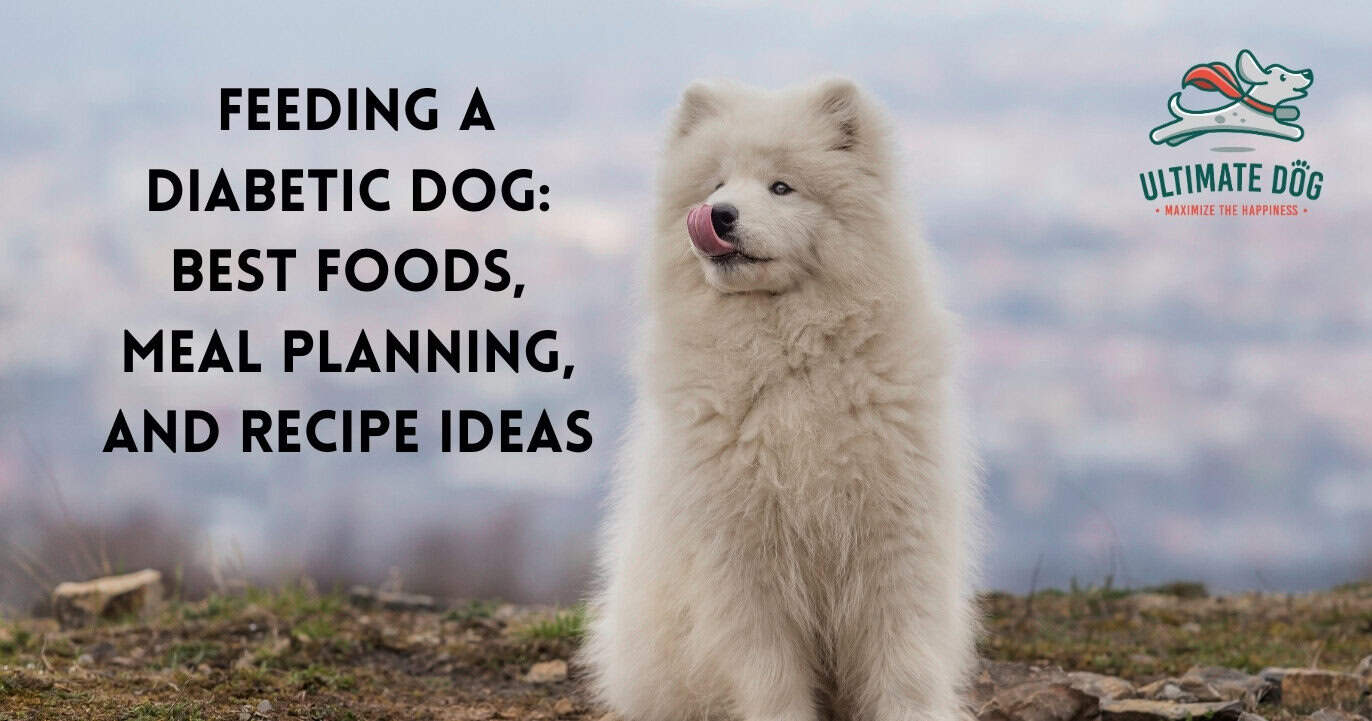So your dog just received a diabetes diagnosis. Before you panic, know that dogs can live long, happy lives with this disease. As a type 1 diabetic of sixteen years myself and someone who has cared for numerous diabetic dogs as the manager of a boarding kennel and home pet sitter, I can attest that this is true.
Through my personal experiences, I’ve learned that what you feed your diabetic dog is one of the most important things in determining their quality of life as this disease progresses.
Feeding a diabetic dog is not easy, but with careful planning and knowledge about how food affects blood sugar levels, you can find the best diet to suit your dog’s needs. We’ll cover all this and more below.
Understanding Canine Diabetes
Canine diabetes affects about 1 in 300 dogs, with most cases diagnosed between the ages of 5 and 12. Some breeds, including the Samoyed, Tibetan Terrier, and Cairn Terrier, are more prone to developing this disease than other dogs.
Diabetes mellitus in dogs is very similar, in terms of presentation and treatment, to type 1 diabetes in humans. Choosing the right dog food for diabetic dogs is essential in managing this condition.
For us, this type of diabetes is typically caused by an autoimmune reaction in which immune cells mistakenly attack beta cells in the pancreas. Beta cells are responsible for producing insulin, which, in turn, enables cells throughout the body to take up glucose from the bloodstream. As these beta cells are destroyed, less insulin is produced, resulting in higher blood glucose concentrations. Excess glucose in the bloodstream causes damage to veins, cardiac muscles, and the kidneys, while cellular starvation due to a lack of usable glucose leads to a host of other problems throughout the body.
In dogs, all cases of diabetes mellitus reach this same result: high blood sugar and damage to organs. But the process that causes these symptoms can differ. Some dogs get diabetes because of an autoimmune reaction similar to humans, while others seem to have a strong genetic component that predestines them to poorly functioning beta cells in old age. Still others end up with diabetes due to drug reactions, pancreatitis, or environmental influences. Interestingly, dogs do not develop insulin resistance-mediated diabetes, as seen in cats or humans with type 2 diabetes.
Because dogs only tend to show symptoms of diabetes after the disease has progressed, almost all dogs will be insulin dependent by the time they are diagnosed. This means that they will require daily insulin injections to live.
Unlike most other medications, dosing insulin is a complex and individualized process that varies from patient to patient. The amount of insulin a dog needs will depend on their size, age, and activity level. It is also highly dependent on their diet. This is because the amount of glucose absorbed into the bloodstream after each meal is directly correlated to the amount of carbohydrates in the food eaten. The type of carbs and the amount of protein also play a role. And this is why selecting good dog food for diabetic dogs is crucial in the long-term management of this disease.
How Diet and Diabetes Are Interconnected
Many people are aware that carbohydrates are broken down by the body and absorbed as glucose. What few people realize is that the type of carbohydrate plays a crucial role in determining how quickly this process occurs. In other words, some carbohydrates cause dangerous spikes in blood sugar while others lead to a more gradual increase, which injectable insulin is better able to control.
Protein, surprisingly, also plays a role in blood sugar levels. Low-carbohydrate, high-protein diets, which are optimal for all dogs, stimulate gluconeogenesis in the body. During this process, glucose is released into the bloodstream from non-carbohydrate sources. While glucose levels are typically much lower following gluconeogenesis, glucose is still created. This means that insulin treatment is still necessary for dogs on low- or no-carb diets.
Another thing that can affect glucose levels is timing. It can take some time for injected insulin to reach its peak effectiveness in the body. Timing meals correctly with insulin shots can help reduce glucose spikes and, in turn, lower your dog’s risk of complications.
The amount of insulin given is another essential factor to consider. Each molecule of insulin is only effective at opening cells to allow a certain number of glucose molecules to enter. This means that the amount of insulin you administer to your dog at each injection must be dosed in the correct ratio for the amount of glucose that will be released into the bloodstream by the corresponding meal.
To put it simply, when it comes to dog food for diabetic dogs, there are several important factors to consider. Not only is the type of food significant, but so is the amount fed and the timing of those feedings.
Key Things to Consider When Choosing Dog Food for Diabetic Dogs
Whether you are looking for commercial food or plan to home-cook your dog’s meals, the best dog food for diabetic dogs really comes down to the ingredients used.
You want to choose a diet that prioritizes lean proteins from quality animal sources. Avoid foods that utilize plant-proteinalternatives, such as peas, legumes, and soybeans, as these protein sources also contain carbohydrates, unlike meat, which is carb-free.
Limiting carbohydrates is also crucial for maintaining balanced blood sugar levels. When shopping for dog food, look for options that don’t contain starches, including potatoes, rice, and corn. Instead, opt for options that rely on low-starch vegetables and complex whole-grains, such as barley and sorghum.
Fiber, which is technically a carbohydrate, is another critical consideration for diabetic dog diets. Insoluble fiber helps food move quickly through your dog’s gut, limiting the amount of calories and glucose absorbed. Soluble fiber, on the other hand, slows digestion and can help with nutrient absorption while slowing glucose absorption. Diets that contain cellulose, low-starch veggies, and whole-grains will have more insoluble fiber than diets that contain beet pulp, guar gum, and psyllium—all of which are high in soluble fiber. Depending on your dog’s needs, how prone they are to glucose spikes, and the overall makeup of their diet, you may want to include more of one type of fiber or a balance of both.
For dogs at a healthy weight, aim for a fiber content of between 5 and 15%. For overweight dogs, a higher fiber content, closer to 20%, can be beneficial.
The last thing to consider is fat content. Typically, low-fat food is recommended for diabetic dogs. This is because 30% of dogs end up with diabetes after suffering beta cell damage due to pancreatitis, a disease exacerbated by high-fat diets. If your dog is overweight or has a history of pancreatitis, aim for a diet that contains only about 20% fat. For dogs that have consistently maintained a healthy weight and have no history of pancreatitis, a diet with approximately 30% fat should be suitable. Since fat slows glucose absorption, opting for higher-fat diets can be advantageous, provided pancreatitis is not a concern.
Key Features of Good Dog Food for Diabetic Dogs:
- High in quality, lean animal protein
- Named, quality meat is the first ingredient
- No starches or sugary ingredients
- All ingredients have a low glycemic index
- Low to moderate fat content (20 to 30%)
- Moderate to high insoluble fiber content (5 to 20%)
- Highly palatable to avoid missed and half-eaten meals
Ingredients to Avoid:
- Potatoes
- Rice
- Pasta
- High protein plant ingredients
- Low-quality meat ingredients
- Grains, especially simple or “white” grains
- Added sugar and sugary ingredients
Commercial Options: What’s the Best Dog Food for Diabetic Dogs?
Choosing a commercial dog food for your pet has some advantages. Not only are these foods easy to feed because they require no prep, but they are also consistent and straightforward to measure. This means that once you find an insulin dosing regimen that works, you can expect it to continue to work, bag after bag.
But these diets also have their downsides. For one, it is challenging to find a commercial diet that meets all the key features of the best dog food for diabetic dogs, unless you are willing to pay a substantial amount. These foods also tend to be highly processed, which means they have lower nutritional values and can cause health problems unrelated to diabetes.
Many vets will recommend prescription diets for diabetic dogs. Unfortunately, the options here leave a lot to be desired. The first five ingredients in the leading prescription diabetic dog food are chicken by-product meal, barley, corn gluten meal, powdered cellulose, and wheat gluten. There isn’t a single quality meat ingredient in the entire bag. While it might contain the right mix of macros to stabilize blood sugar, it provides nothing to help your dog thrive.
In terms of dry dog food for diabetic dogs, in general, there aren’t many great options. This is because dry food requires starchy ingredients to hold it together during processing. If you are set on feeding a commercial diet, a raw, freeze-dried, air-dried, or dehydrated option is the best choice. Use our “key features” list from above to find one suited for diabetic dogs.
Homemade Dog Food for Diabetic Dogs: Vet-Approved Recipes
If you want to feed your dog a quality diet that supports balanced blood sugar and doesn’t break the bank, the best option is to make the food yourself.
Homemade dog food for diabetic dogs gives you control over the quality, ingredients used, and processing methods. While it may take longer to find the correct insulin and insulin dose that complements these diets, it is worth it in the long run, as your dog will be healthier and better able to overcome the long-term effects of living with diabetes.
Here are some cooked and raw veterinary-approved homemade diabetic dog food recipes that you can easily make yourself. Best of all, they meet all of our key features for good dog food for diabetic dogs.
Cooked Homemade Diabetic Dog Food Recipes
Notes: Choose organic ingredients when possible. Lightly cook with the lid on to retain maximum nutritional value.
1. Turkey & Green Beans
Ingredients:
- 1 lb ground turkey breast
- 2 oz turkey or chicken liver, chopped
- 1 cup green beans
- ½ cup broccoli florets
- 1 tbsp ground flaxseed
- 1 tsp fish oil
- ½ tsp eggshell powder
Instructions:
- Cook turkey until browned, add liver for last 2 minutes of cooking.
- Lightly steam veggies.
- Mix all ingredients and portion out.
2. Chicken & Spinach
Ingredients:
- 1 lb diced skinless chicken breast
- 2 oz chicken gizzards or heart, chopped
- 1 cup spinach, wilted
- ½ cup cauliflower rice, steamed
- 1 tbsp chia seeds
- ½ tsp eggshell powder
- 1 tsp olive oil
Instructions:
- Cook chicken breast and gizzards together until fully done.
- Add spinach and cauliflower.
- Stir in chia seeds, oil, eggshell powder
- Portion out.
3. Beef & Pumpkin
Ingredients:
- 1 lb lean ground beef (90% lean)
- 2 oz beef liver, chopped
- ½ cup pumpkin puree (unsweetened, no spices)
- 1 cup zucchini, grated
- 1 tbsp psyllium husk
- ½ tsp ground bone meal (or eggshell powder)
Instructions:
- Cook beef and liver together.
- Mix in pumpkin, zucchini, and psyllium.
- Stir in ground bone meal after cooking.
Raw Homemade Diabetic Dog Food Recipes
Notes: Use human-grade meat and organs, and opt for organic ingredients whenever possible. Freeze the mixture (or meat ingredients) for 2 to 3 weeks before feeding to minimize the risk of pathogen contamination.
1. Raw Turkey & Spinach
Ingredients:
- 1 lb raw turkey thigh, ground
- 2 oz raw turkey or chicken liver, finely minced
- 1 cup spinach, chopped
- ½ cup cucumber, diced
- 1 tbsp ground flaxseed
- ½ tsp eggshell powder
Instructions:
- Mix all ingredients thoroughly.
- Portion out.
- Refrigerate or freeze.
5. Raw Beef & Kale Mix
Ingredients:
- 1 lb lean grass-fed beef, ground
- 2 oz beef heart, minced
- 1 cup kale, chopped
- ½ cup celery, diced
- 1 tsp fish oil
- ½ tsp ground bone meal
Instructions:
- Mix all ingredients thoroughly.
- Portion out.
- Refrigerate or freeze.
6. Raw Chicken & Broccoli
Ingredients:
- 1 lb raw chicken breast, cubed or ground
- 2 oz chicken gizzard, minced
- ½ cup broccoli florets, finely chopped
- ½ cup zucchini, shredded
- 1 tbsp chia seeds (soaked in water)
- ½ tsp eggshell powder
Instructions:
- Mix all ingredients thoroughly.
- Portion out.
- Refrigerate or freeze.
Home-Made Dog Food for Diabetic Dogs: Considerations
As with home-prepared meals for any dog, variety is key. We recommend alternating the above recipes frequently to ensure your dog receives all the necessary nutrients to thrive. Consider adding a whole-food canine multivitamin supplement to fill any gaps.
Additional supplements, such as brewer’s yeast, cranberry, kelp, parsley, and extra fish oil, can also be beneficial for diabetic dogs. Antioxidants and superfoods, such as those found in CHIRP Superfood Topper, have also been proven to help diabetic dogs thrive. You can get your CHIRP here.
When introducing any new diet to a diabetic dog, it is vital to work with your veterinarian to adjust their insulin dosage. Most vets recommend feeding diabetic dogs the same amount of food at the same times every day, typically ten to twelve hours apart.
The recipes above have all been tailored to contain about the same amount of protein, carbohydrates, fats, and fiber. This makes introducing variety into your dog’s diet easier. Still, we recommend starting with one of these recipes and adjusting the insulin dosage accordingly. Once you have achieved target glucose levels with one recipe, introduce variety slowly and be sure to check your dog’s blood glucose levels frequently, adjusting insulin or portions as needed.
Final Thoughts
When it comes to dog food for diabetic dogs, the most important considerations are the quality of the ingredients that make up the diet, limiting carbohydrates, controlling fat intake, and ensuring appropriate insulin dosing. Diets that are high in quality, lean meats and organ meats, low in starch, and minimally processed will provide your dog with everything they need to thrive, while reducing glucose spikes and diabetic complications.
Use our recipes above to create a balanced, diabetes-friendly diet for your dog to help them thrive despite their disease.
Sources
Animal models of disease: classification and etiology of diabetes in dogs and cats. (2014). Journal of Endocrinology, 222–222, T1–T9.
Behrend, E., Holford, A., Lathan, P., Rucinsky, R., & Schulman, R. (2018). 2018 AAHA Diabetes Management Guidelines for Dogs and Cats*. Journal of the American Animal Hospital Association, 54(1), 1–21.
Catchpole, B., Ristic, J. M., Fleeman, L. M., & Davison, L. J. (2005). Canine diabetes mellitus: can old dogs teach us new tricks? Diabetologia, 48(10), 1948–1956.
Diets for diabetic dogs. (n.d.). Cornell University College of Veterinary Medicine.
Teshima, E., Brunetto, M. A., Teixeira, F. A., De Oliveira Sampaio Gomes, M., Lucas, S. R. R., Pereira, G. T., & Carciofi, A. C. (2021). Influence of type of starch and feeding management on glycaemic control in diabetic dogs. Journal of Animal Physiology and Animal Nutrition, 105(6), 1192–1202.





Leave a Comment